

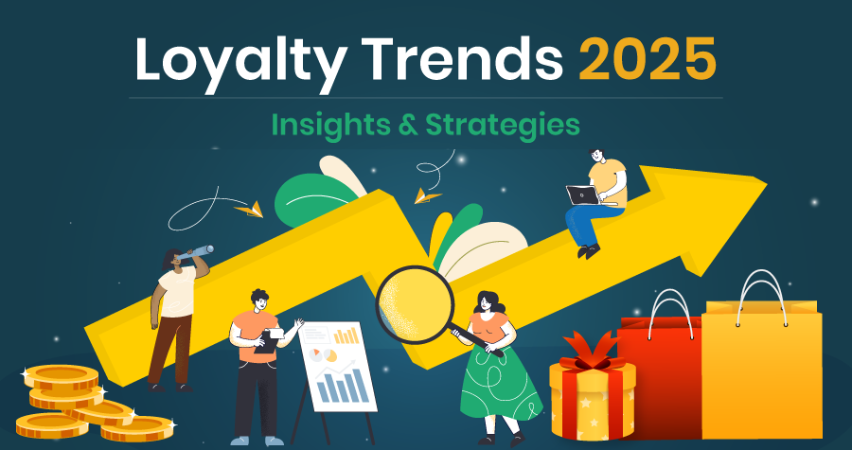
In 2025, loyalty programs will be central to boosting Customer Lifetime Value (CLV), reducing churn, and increasing purchase frequency.
Companies will focus on personalised communication, extending loyalty offerings, and enhancing rewards to meet rising consumer expectations. With inflation and economic uncertainties driving consumers to seek more value, loyalty programs must go beyond traditional discounts.
Customers will demand tailored experiences, powered by AI and data, to ensure meaningful interactions and rewards that align with their shopping behaviours and lifestyles.
In 2024, experiential loyalty, AI-driven features, and using loyalty points at point of sale (POS) became key to successful programs, driven by consumers’ desire for personalised, seamless experiences.
In 2025, shoppers will demand even more tailored rewards based on their behaviours and lifestyles. Retailers will need to evolve their loyalty programs to maintain engagement and strengthen customer loyalty.
As loyalty programs evolve, brands will look to offer more than just points, expanding rewards to include exclusive experiences, sustainable incentives, and personalized services. These changes will help foster stronger emotional connections with customers, ensuring they feel valued and engaged. By investing in hyper-personalisation and flexible rewards, companies can reduce churn, encourage repeat purchases, and drive long-term loyalty—making these programs a critical driver of growth in 2025.
Let’s take a closer look at the key trends set to shape the loyalty program landscape in 2025.
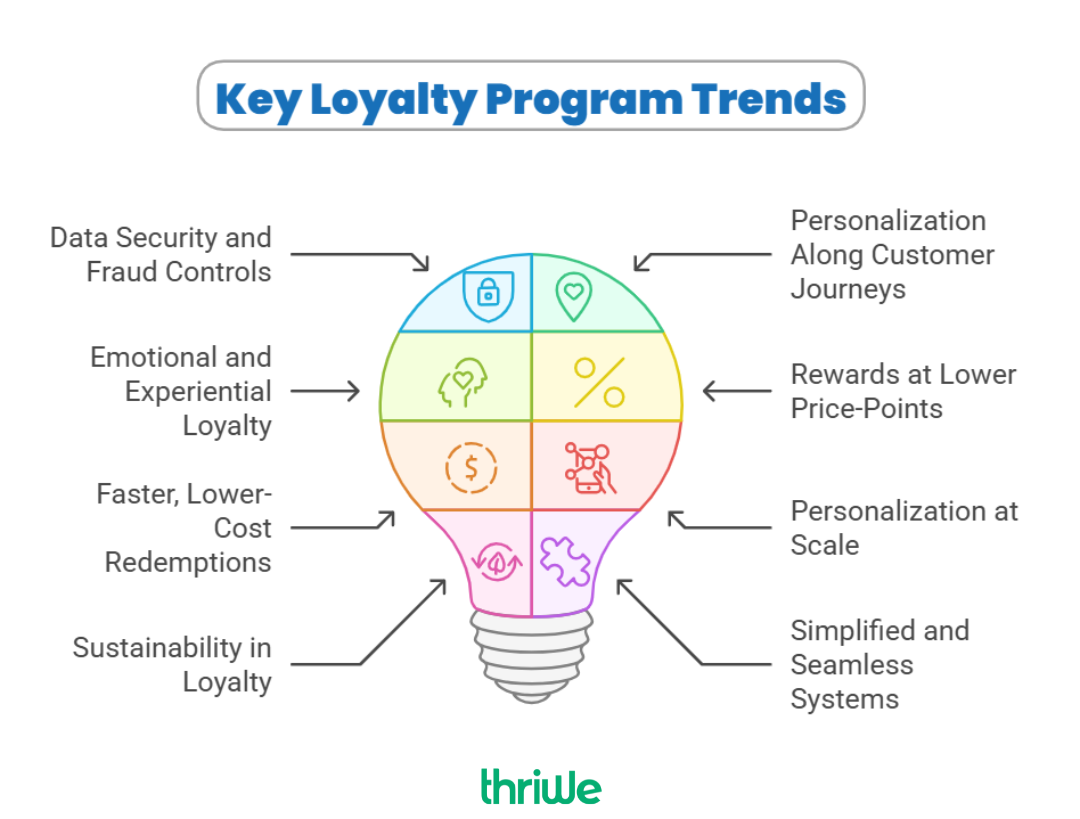
As we look toward 2025, several key trends are set to redefine loyalty programs, with brands focusing on innovation, security, and deeper customer connections. Here’s a look at the trends shaping the future of loyalty.
Loyalty fraud is rising rapidly, with loyalty points becoming a prime target for financial crime. In 2024, it was the fourth fastest-growing type of fraud, with an estimated $0.5 trillion in loyalty currencies at risk. Brands are starting to take security seriously, and in 2025, we’ll see significant upgrades to loyalty account protection, making them as secure as bank accounts to safeguard customer data and prevent fraud.
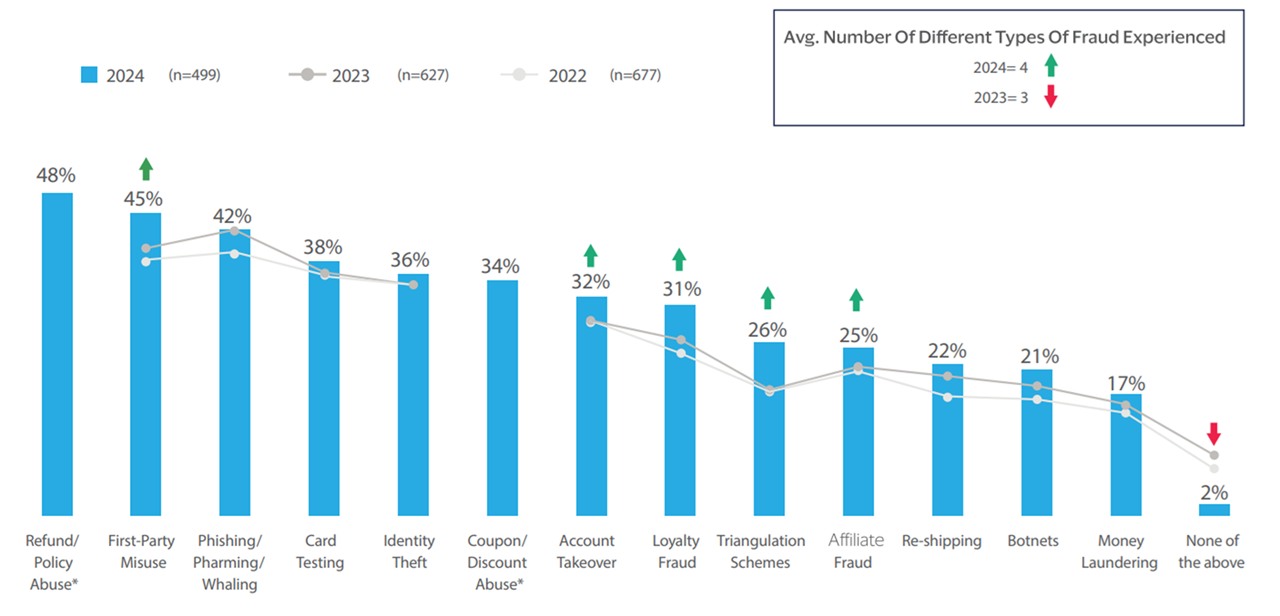
With advancements in AI and data organization, 2025 will bring an explosion of personalised loyalty offerings. Brands will use enriched customer profiles (due to the advent of AI) to extend loyalty beyond simple transactions, delivering rewards and experiences tailored to individual behaviours and preferences, deepening customer engagement across longer journeys.
While transactional loyalty remains foundational, emotional loyalty is gaining ground in 2025. Brands are leveraging technology like GPS and fitness trackers to offer rewards for non-purchase behaviours, such as exercising or engaging with the brand in meaningful ways. By incorporating emotional triggers into the customer experience, brands can build stronger, more personal connections.
Brands are shifting toward offering rewards to even infrequent customers, breaking down the barriers that traditionally made higher-value rewards exclusive to frequent shoppers. This trend will help businesses boost customer acquisition and retention, as lower price-point rewards attract a broader audience and uncover previously untapped high-potential customers.
Customers are increasingly seeking quicker, more tangible rewards than traditional points-based systems can provide.
A recent survey in Britain revealed that the most appealing loyalty benefits for customers are discounts (85%), followed by monetary rewards like vouchers (82%), and freebies (67%), both for points accumulation and immediate purchases. While discounts and vouchers can cost brands more than points, vouchers are particularly effective at encouraging return visits due to the perceived value and future savings they offer to customers.
Traditionally, bank loyalty programs allowed points to be redeemed for travel rewards, but now non-bank and non-travel brands are offering similar exchanges to complementary brands. This move toward faster, low-cost redemptions offers immediate value to customers, driving repeat business and increasing program participation.
Personalised loyalty is a core strategy for 2025, as brands use AI and big data to offer real-time, tailored rewards and experiences. Companies like Amazon and Sephora are already leading the way, and brands will need to align rewards with customer values to foster deeper connections, ultimately increasing CLV.
GenAI, machine learning, and automation will play a major role towards this end since they have the potential to revolutionise loyalty programs by delivering real-time rewards, hyper-personalised experiences, and increased efficiency at a lower cost. By analysing purchase history, customer feedback, social media interactions, demographics, and preferences and behaviours of loyalty members, these tools can create predictive models to meet individual needs, improving program accessibility and reducing response times.
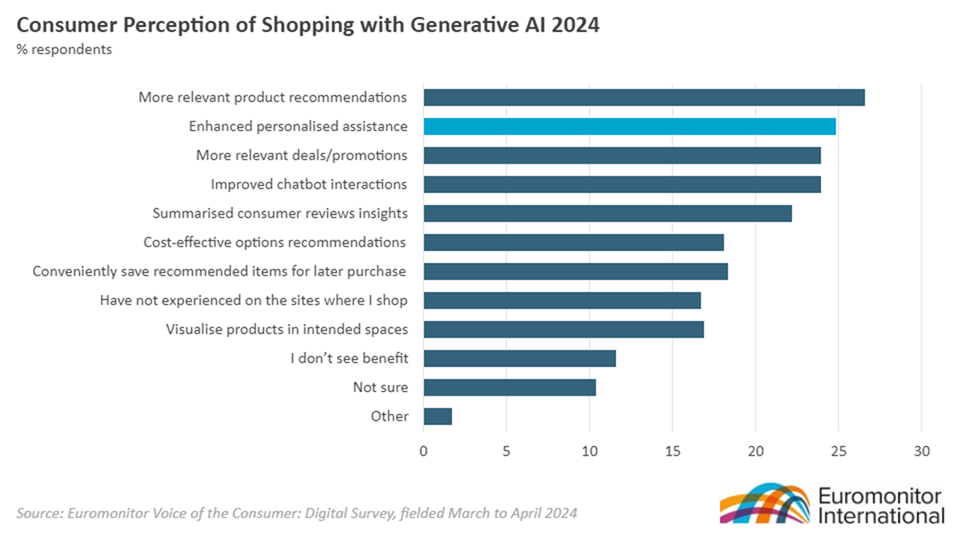
These technologies will allow companies to deliver timely, relevant offers, track customer behaviour, and engage more consistently, both online and in-store, without adding significant labour costs.
According to Euromonitor’s Voice of the Consumer: Sustainability Survey conducted from January to February 2024, nearly two-thirds of global consumers are concerned about climate change and actively make eco-friendly choices.
With rising consumer concern over climate change, sustainability will become a central focus in 2025 loyalty programs. Customers will favour brands that offer eco-friendly rewards and partner with organizations that share their environmental values. Embracing sustainability not only enhances brand image but also deepens emotional loyalty, positioning companies as leaders in an increasingly eco-conscious market.
Loyalty programs should offer a simple and efficient experience, but they often require extra steps for members to access rewards. Embedded loyalty removes these barriers by integrating rewards directly into products or services, eliminating the need for separate sign-ups or interactions.
As this approach becomes more common, consumers will expect seamless, rewarding experiences across all touchpoints, raising industry standards. While many programs are digital, the next step will be incorporating embedded loyalty into the entire omnichannel experience. To stand out, brands must ensure their earning and redemption processes are smooth and provide real value.
By embracing these trends, brands can enhance customer loyalty, increase engagement, and drive long-term business growth in 2025.
The future of loyalty programs in 2025 will be shaped by innovative models focused on AI-driven personalisation, gamification, and experience-based rewards. These trends will move beyond traditional transactional rewards, creating more engaging, personalized, and immersive experiences for customers.
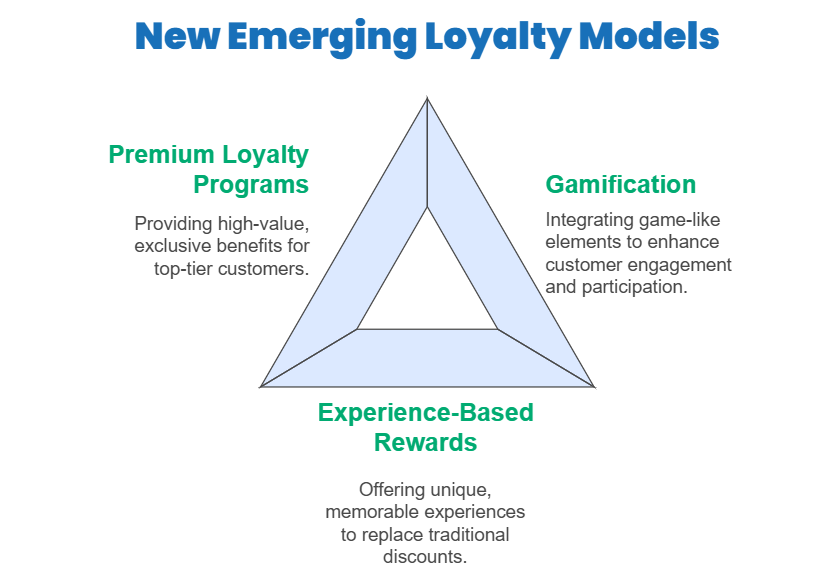
Gamification is set to be a major trend, with 47% of consumers seeking more playful, immersive experiences. By integrating game-like elements such as challenges, levels, and badges, brands can turn loyalty programs into a more engaging experience. This not only encourages ongoing participation but also strengthens the emotional connection between brands and customers. For example, platforms like Biscuit use gamified features to boost customer engagement, rewarding actions like completing challenges. In 2025, expect more brands to adopt gamification to create a fun, rewarding, and long-term relationship with customers.
In 2025, loyalty will be increasingly driven by exclusive experiences rather than traditional discounts. Consumers are shifting from transactional rewards to unique, memorable experiences—like VIP events, personalised consultations, or special access to new product launches. Brands like Sephora’s Beauty Insider are leading the way, offering tailored beauty consultations and exclusive shopping experiences. This model taps into the growing demand for personalized, lifestyle-oriented rewards that go beyond the typical point-based systems.
Premium loyalty programs are gaining traction, offering high-value rewards and exclusive benefits for top-tier customers. Programs like Amazon Prime and Walmart+ have shown that consumers are willing to pay for memberships that provide tangible, ongoing value—such as early product access, discounts, and special events. This trend signals a shift in how loyalty is perceived, with customers seeking ongoing benefits rather than one-off perks. As more businesses invest in premium program features, loyalty will become a must-have service that provides consistent value.
In 2025, loyalty programs will increasingly integrate these innovative models, shifting focus from simple transactions to building long-term, immersive, and meaningful customer relationships. By offering personalized experiences, game-like engagement, and exclusive rewards, brands will strengthen customer loyalty and drive greater engagement.
As loyalty programs evolve in 2025, brands will face several key challenges, from balancing privacy with personalisation to proving the return on investment (ROI) of loyalty initiatives. With the growing demand for personalised experiences, brands must strike a delicate balance between leveraging customer data and respecting privacy concerns. Additionally, economic pressures and the saturation of loyalty programs will require businesses to rethink how they measure success and differentiate themselves in a crowded market.
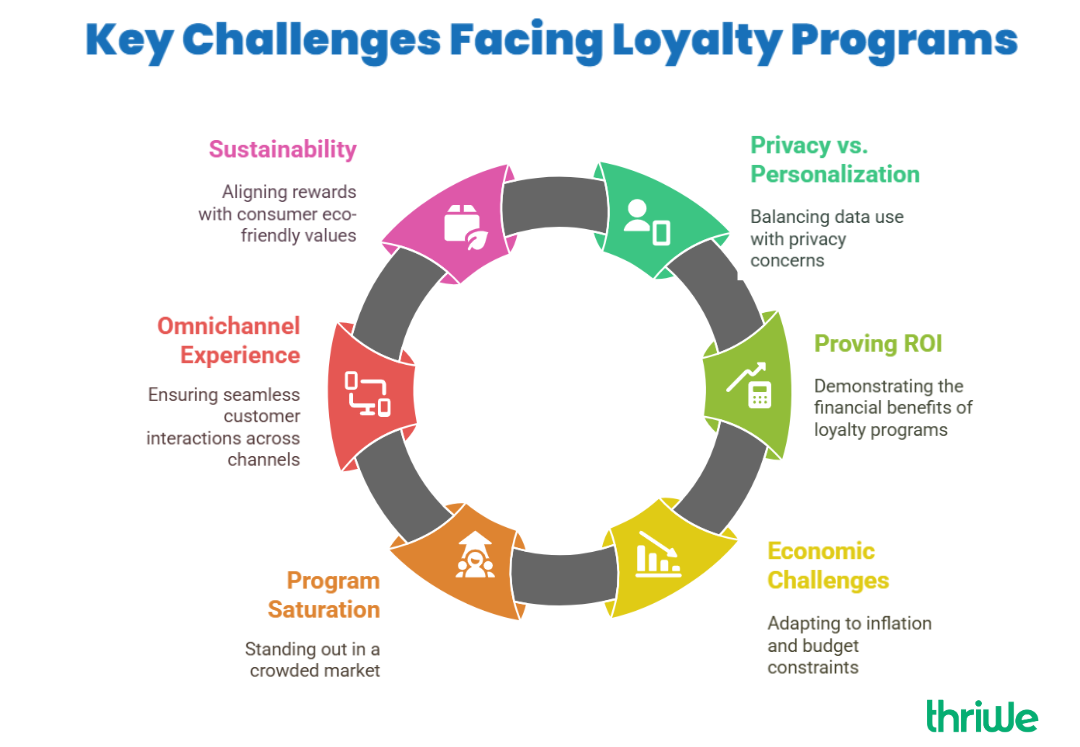
Consumers are increasingly aware of how their data is used, with 63% of internet users believing companies lack transparency. To remain compliant with data protection regulations like General Data Protection Regulation (GDPR), brands must prioritise data security and transparency while still offering tailored rewards and experiences. Striking this balance will be crucial for building trust and maintaining long-term customer loyalty.
As economic pressures mount, proving the ROI of loyalty programs will become a top priority. Brands must track key metrics like CLV, engagement rates, and retention to demonstrate the long-term financial benefits of their initiatives. The need for advanced analytics tools that can seamlessly track program effectiveness will be critical in justifying loyalty investments.
With inflation and economic uncertainty impacting consumer spending, brands will need to rethink how they allocate resources to loyalty programs. Consumers may become more price-sensitive, making it harder for brands to deliver the aspirational rewards of the past. Loyalty programs must provide tangible, immediate value to remain relevant while navigating the pressures of tightened budgets and rising costs.
As more brands introduce loyalty programs, customers are becoming overwhelmed by choice. Standing out and keeping customers engaged in such a crowded market will be a challenge. To cut through the noise, brands will need to continuously innovate their offerings, ensuring they provide personalised and meaningful rewards that go beyond simple transactional benefits.
With customers interacting with brands across multiple touchpoints—from in-store to mobile apps to websites—ensuring a seamless omnichannel experience will be vital. Loyalty programs must integrate across all channels, providing a consistent and personalised experience regardless of how the customer engages with the brand. Leveraging AI to create a cohesive, omnichannel strategy will be essential for maintaining high levels of customer satisfaction and loyalty.
As consumers increasingly prioritise sustainability, loyalty programs must reflect these values by offering eco-friendly rewards or partnering with sustainable brands. Consumers expect programs to align with their ethical values, and brands that fail to do so may risk losing customer loyalty. Offering sustainable rewards will become a significant differentiator for brands in 2025.
Loyalty programs in 2025 will need to adapt to these challenges by embracing data transparency, demonstrating ROI, innovating in the face of economic pressures, and offering seamless omnichannel and sustainable experiences. The brands that navigate these complexities effectively will lead the way in building lasting customer relationships.
In 2025, businesses will be shifting their focus from acquisition to retention, prioritising CLV and reducing churn. Companies will leverage tools that foster deeper engagement, creating sustained interactions that build loyalty and ensure consistent revenue.
To accomplish this, businesses will implement advanced analytics and personalised engagement strategies, ensuring that their current customer base remains loyal and active.
As we look toward 2025, businesses are making strategic investments to enhance customer engagement and drive loyalty. The focus is clear: companies aim to elevate the customer experience through gamification, marketing automation, and experience-based rewards.
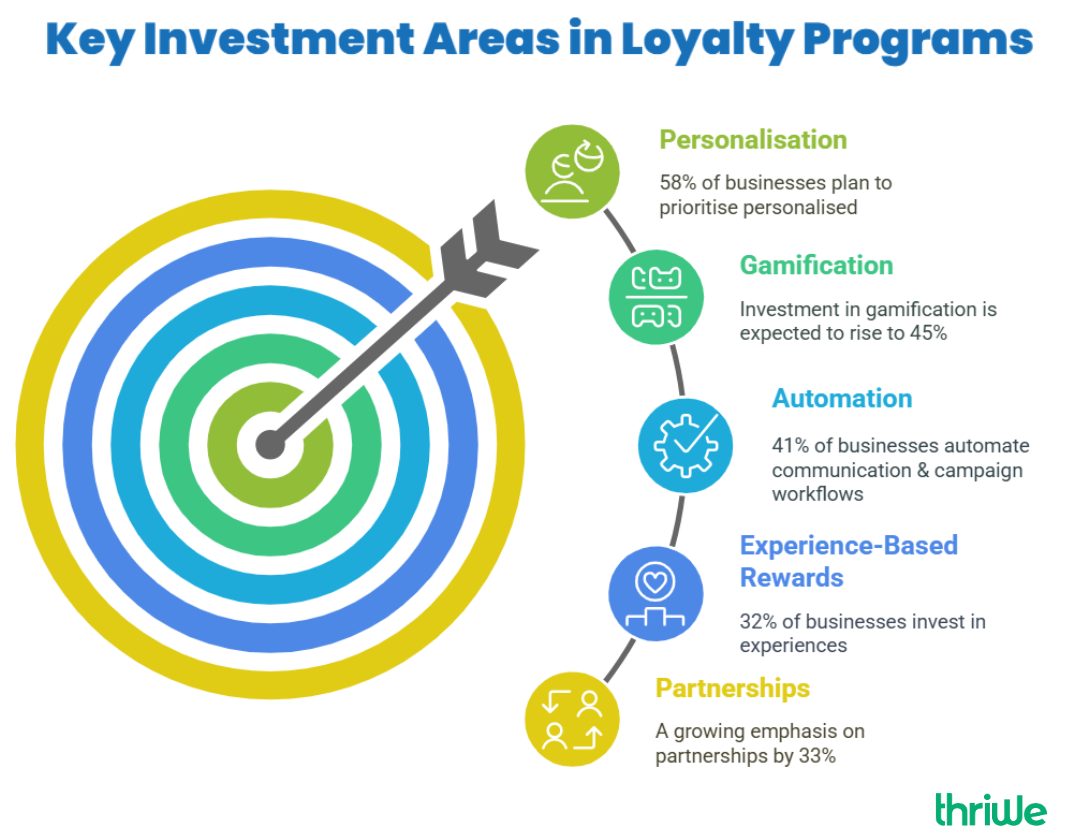
58% of businesses plan to prioritise personalised loyalty experiences, reflecting the growing importance of tailored offerings that boost customer engagement, retention, and long-term value.
Investment in gamification is expected to rise to 45%, as companies incorporate game-like mechanics such as points, badges, and challenges to create more engaging, interactive loyalty programs.
With a 41% focus on marketing automation, businesses are automating communication and campaign workflows, reducing complexity while delivering more timely and relevant interactions with customers.
32% of businesses are investing in experience-based rewards, offering exclusive experiences instead of traditional transactional rewards, creating more memorable and personalised interactions for customers.
A growing emphasis on partnerships (33%) shows that brands are leveraging collaborations to extend the value of their loyalty programs, offering complementary benefits and expanding reach to enhance customer loyalty.
These investments signal a broader trend toward creating deeper, more engaging customer relationships, focusing on experiences and long-term engagement rather than simple transactional rewards.
As we approach 2025, loyalty programs are poised to become the cornerstone of customer engagement, retention, and growth. Brands are shifting their focus from traditional acquisition strategies to long-term relationships, emphasizing personalisation, gamification, and experience-based rewards. The demand for more meaningful, tailored experiences is driving investments in AI, automation, and partnerships, while also highlighting the importance of data security and fraud prevention.
To stay competitive in an increasingly crowded market, companies must adapt to changing consumer expectations by offering rewards that go beyond points and discounts. Sustainability and ethical values will also play a central role in building lasting emotional connections with customers.
Ultimately, loyalty programs in 2025 will not just be about transactions—they will be about creating engaging, personalised, and memorable experiences that foster deeper relationships and drive long-term customer loyalty. By embracing these trends and challenges, brands will be well-equipped to thrive in a rapidly evolving landscape, ensuring sustained growth and success in the years to come.
To stay ahead of the curve and create impactful loyalty programs in 2025, explore how Thriwe can help you build personalised, experience-driven rewards that resonate with your customers.